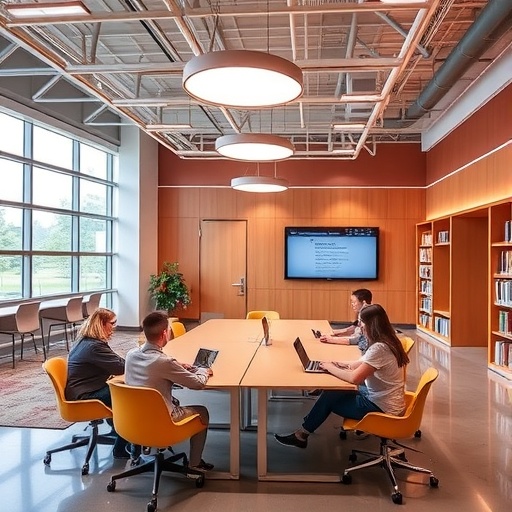In an era where education is evolving at an unprecedented pace, the need for innovative designs in learning environments has taken center stage. M.J. Orihuela’s groundbreaking research explores active learning environments specifically tailored to harmonize with pedagogical principles, underscoring the significance of spatial design in school workshop spaces. This advanced perspective on educational architecture emphasizes the transformation of conventional classrooms into dynamic hubs of creativity and collaboration.
The crux of Orihuela’s research lies in the assertion that the physical layout and spatial organization of a learning space can significantly influence student engagement and success. Incorporating pedagogical principles into the design framework fosters environments conducive to active learning, thus challenging traditional educational paradigms. This shift from passive to active learning necessitates a meticulous approach to how educators and architects conceptualize and implement learning spaces.
Active learning, characterized by student-centric methodologies, promotes collaboration, critical thinking, and experiential learning. Orihuela’s work elucidates how the physical arrangement of workshop spaces can either facilitate or hinder these educational objectives. Her study provides a spatial design tool that guides educators in creating environments that are not only functional but also inspiring, making students the architects of their own learning experiences.
One of the pivotal aspects of this research is the acknowledgment that different teaching strategies require varied spatial configurations. For instance, collaborative projects might benefit from open spaces that encourage communication and teamwork, whereas individual tasks may necessitate quieter, more secluded areas. Orihuela’s spatial design tool is equipped with guidelines that align specific pedagogical strategies with appropriate spatial setups, ensuring that the physical space mirrors the intended teaching methodologies.
The research delves deep into the nuances of how color, light, and materials influence learning outcomes. By analyzing existing literature, Orihuela reveals that natural light significantly contributes to students’ well-being and cognitive functions, while color schemes can evoke particular emotions and stimulate creativity. These insights propel educators to carefully consider not only the function of a space but also its aesthetic contribution to the educational experience.
Furthermore, the integration of technology within school workshops cannot be overlooked. In today’s digital age, the synthesis of traditional learning with technological advancements allows for a more comprehensive educational approach. Orihuela’s findings advocate for versatile designs that accommodate technological tools, enabling students to engage with interactive content seamlessly. This adaptability ensures that learning environments remain relevant in the face of rapid technological changes.
Another critical consideration highlighted in Orihuela’s research is the importance of flexibility in space design. A static layout may stifle creativity and adaptability, whereas modular and flexible environments empower educators to rearrange spaces to meet diverse needs. This adaptability facilitates a range of learning activities, from hands-on projects to group discussions, cementing the space’s role in reinforcing diverse learning experiences.
Collaboration is paramount in the modern educational ecosystem, and Orihuela’s spatial design tool emphasizes the essential elements that nurture this aspect. By designing spaces that encourage interaction among students, educators can foster a culture of sharing ideas, knowledge, and skills. The tool encapsulates strategies to create informal gathering points within classrooms, thereby enhancing the social dynamics crucial for effective learning.
Reflecting on the implications of this research, it becomes evident that the design of educational spaces requires a holistic approach that considers socio-cultural factors. Various demographics and communities engage with educational content differently, necessitating designs that respect these nuances. Orihuela’s research provides a framework that is adaptable to different educational contexts, promoting inclusivity and diversity in learning environments.
The urgency of implementing these innovative design principles cannot be overstated. In a world that increasingly values collaboration and innovation, the conventional classroom model can be a limiting factor. Orihuela’s research offers a timely intervention, equipping educators and stakeholders with the knowledge they need to implement changes that resonate with contemporary educational needs.
Furthermore, the implications of Orihuela’s study extend beyond educational institutions. As we grapple with global challenges, fostering creativity and collaboration in young minds becomes more crucial than ever. School workshops designed with active learning principles are fertile grounds for nurturing the next generation of problem-solvers and innovators who can address complex issues with ingenuity.
As this research sheds light on the importance of design in education, it paves the way for further investigations. Future studies could explore longitudinal outcomes of educational environments transformed through these design principles, assessing their long-term impact on learning success and student wellbeing. Additionally, interdisciplinary collaborations could yield innovative solutions that incorporate insights from psychology, architecture, and education, further enriching the dialogue around effective learning environments.
In conclusion, M.J. Orihuela’s work not only redefines the conversation around educational spaces but also catalyzes a meaningful shift towards environments that foster active and engaged learning. Her spatial design tool serves as a beacon for educators and architects alike, guiding the way in creating dynamic spaces that are tailored to the evolving needs of students. By embracing these principles, schools can cultivate environments where creativity flourishes, collaboration is inherent, and learning is truly transformative.
Subject of Research: Active learning environments and their spatial design in educational settings.
Article Title: Active learning environments tailored to pedagogical principles: a spatial design tool for school workshop spaces.
Article References: Orihuela, M.J. Active learning environments tailored to pedagogical principles: a spatial design tool for school workshop spaces.
Discov Educ 4, 466 (2025). https://doi.org/10.1007/s44217-025-00869-w
Image Credits: AI Generated
DOI: 10.1007/s44217-025-00869-w
Keywords: Active learning, educational design, spatial organization, student engagement, workshop spaces.




